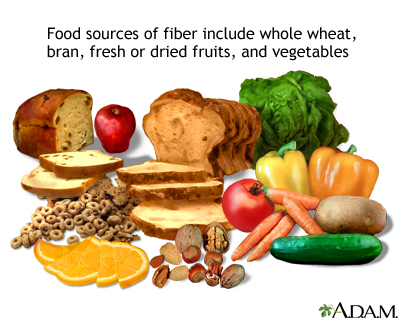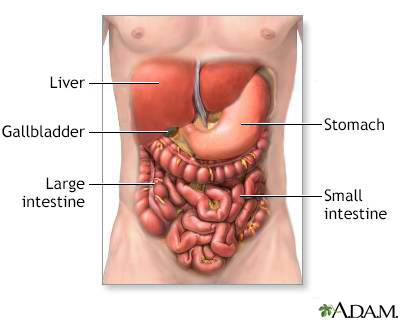Constipation in infants and children
Definition
Constipation in infants and children means they have hard stools or have problems passing stools. A child may have pain while passing stools or may be unable to have a bowel movement after straining or pushing.
Alternative Names
Irregularity of bowels; Lack of regular bowel movements
Considerations
Constipation is common in children. However, normal bowel movements are different for each child.
In the first month, infants tend to have bowel movements about once a day. After that, babies can go a few days or even a week between bowel movements. It's also difficult to pass stools because their abdominal muscles are weak. So babies tend to strain, cry, and get red in the face when they have a bowel movement. This does not mean they are constipated. If bowel movements are soft, then there is likely no problem.
Signs of constipation in infants and children may include:
- Being very fussy and spitting up more often (infants)
- Difficulty passing stools or seeming uncomfortable
- Hard, dry stools
- Pain when having a bowel movement
- Belly pain and bloating
- Large, wide stools
- Blood on the stool or on toilet paper
- Traces of liquid or stool in a child's underwear (may be a sign of fecal impaction)
- Having less than 3 bowel movements a week (children)
- Moving their body in different positions or clenching their buttocks
Make sure your infant or child has a problem before treating constipation:
- Some children do not have a bowel movement every day.
- Also, some healthy children always have very soft stools.
- Other children have firm stools, but are able to pass them without problems.
Causes
Constipation occurs when the stool remains in the colon for too long. Too much water gets absorbed by the colon, leaving hard, dry stools.
Constipation may be caused by:
- Ignoring the urge to use the toilet
- Not eating enough fiber
- Not drinking enough fluids
- Switching to solid foods or from breast milk to formula (infants)
- Changes in situation, such as travel, starting school, or stressful events
Medical causes of constipation may include:
- Diseases of the bowel, such as those that affect the bowel muscles or nerves
- Other medical conditions that affect the bowel
- Use of certain medicines
Children may ignore the urge to have a bowel movement because:
- They are not ready for toilet training
- They are learning to control their bowel movements
- They have had previous painful bowel movements and want to avoid them
- They don't want to use a school or public toilet
Home Care
Lifestyle changes can help your child avoid constipation. These changes can also be used to treat it.
For infants:
- Give your baby extra water or juice during the day in between feedings. Juice can help bring water to the colon.
- Over 2 months old: Try 2 to 4 ounces (59 to 118 mL) of fruit juice (grape, pear, apple, cherry, or prune) twice a day.
- Over 4 months old: If the baby has started to eat solid foods, try baby foods with high-fiber content such as peas, beans, apricots, prunes, peaches, pears, plums, and spinach twice a day.
For children:
- Drink plenty of fluids each day. Your child's health care provider can tell you how much.
- Eat more fruits and vegetables and foods high in fiber, such as whole grains.
- Avoid certain foods such as cheese, fast food, prepared and processed foods, meat, and ice cream.
- Stop toilet training if your child becomes constipated. Resume after your child is no longer constipated.
- Teach older children to use the toilet right after eating a meal.
Stool softeners (such as those containing docusate sodium) may help for older children. Bulk laxatives such as psyllium may help add fluid and bulk to the stool. Suppositories or gentle laxatives may help your child have regular bowel movements. Electrolyte solutions like Miralax can also be effective.
Some children may need enemas or prescription laxatives. These methods should be used only if fiber, fluids, and stool softeners do not provide enough relief.
Do not give laxatives or enemas to children without first asking your child's provider.
When to Contact a Medical Professional
Contact your child's provider right away if:
- An infant (except those who are only breastfed) goes 3 days without a stool and is vomiting or irritable
Also contact your child's provider if:
- An infant younger than 2 months is constipated.
- Non-breastfeeding infants go 3 days without having a bowel movement (Contact your child's provider right away if there is vomiting or irritability.)
- A child is holding back bowel movements to resist toilet training.
- There is blood in the stools.
What to Expect at Your Office Visit
Your child's provider will perform a physical exam. This may include a rectal exam.
The provider may ask you questions about your child's diet, symptoms, and bowel habits.
The following tests may help find the cause of constipation:
- Blood tests such as a complete blood count (CBC)
- X-rays of the abdomen
The provider may recommend the use of stool softeners or laxatives. If stools are impacted, glycerin suppositories or saline enemas may be recommended also.
Gallery


References
Kwan KY. Abdominal pain. In: Olympia RP, O'Neill RM, Silvis ML, eds. Urgent Care Medicine Secrets. Philadelphia, PA: Elsevier; 2018:chap 19.
Maqbool A, Liacouras CA. Major symptoms and signs of digestive tract disorders. In: Kliegman RM, St. Geme JW, Blum NJ, Shah SS, Tasker RC, Wilson KM, eds. Nelson Textbook of Pediatrics. 21st ed. Philadelphia, PA: Elsevier; 2020:chap 332.
National Institute of Diabetes and Digestive and Kidney Diseases. Constipation in children. www.niddk.nih.gov/health-information/digestive-diseases/constipation-children/definition-facts. Updated May 2018. Accessed September 20, 2022.
Rutter P, Gastroenterology. In: Rutter P, ed. Community Pharmacy. 5th ed. Philadelphia, PA: Elsevier; 2021:chap 7.
